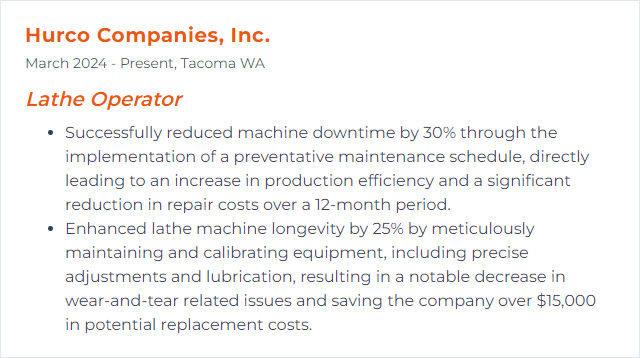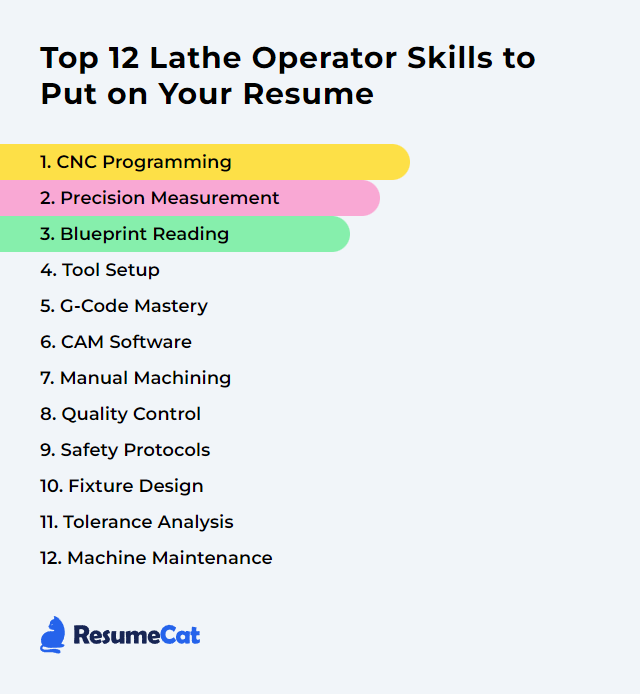Top 12 Lathe Operator Skills to Put on Your Resume
Crafting a standout resume as a lathe operator means showing the precise, methodical, hands-on work you do every shift. The blend of machine fluency, measurement discipline, and calm problem-solving under chips and coolant. Highlight the skills that prove you can hit tolerance, keep parts flowing, and do it safely—day after day.
Lathe Operator Skills
- CNC Programming
- Precision Measurement
- Blueprint Reading
- Tool Setup
- G-Code Mastery
- CAM Software
- Manual Machining
- Quality Control
- Safety Protocols
- Fixture Design
- Tolerance Analysis
- Machine Maintenance
1. CNC Programming
CNC programming for a lathe operator means writing and editing instructions that command the machine to cut, turn, groove, drill, and finish material exactly as intended. Feeds, speeds, tool paths, offsets, and safe moves all living in code that must run clean, repeatable, and fast.
Why It's Important
Good programming drives accuracy and repeatability. It trims cycle time, protects tools, prevents crashes, and unlocks complex geometry without fuss.
How to Improve CNC Programming Skills
Build strong fundamentals: Work offsets (G54+), canned cycles, tool nose radius compensation, constant surface speed, safe start lines.
Standardize: Use proven header/footer blocks, macros, and subprograms. Name tools consistently. Keep a template library.
Prove out safely: Graphics, single-block, dry run, feed hold, and slow overrides. Verify every tool change and clearance move.
Optimize toolpaths: Reduce air cutting, shorten rapids, use pecking where needed, balance roughing vs finishing stock.
Use data: Track cycle times, tool life, and scrap. Tweak feeds/speeds and DOC based on hard numbers, not hunches.
Stay current: Learn machine- and control-specific G/M codes. Keep up with new inserts, materials, and strategies.
How to Display CNC Programming Skills on Your Resume

2. Precision Measurement
Precision measurement means using micrometers, indicators, bore gauges, thread gauges, height stands, and surface plates to confirm parts meet spec—every diameter, length, form, and finish.
Why It's Important
Without trustworthy measurements, good parts look bad and bad parts slip through. Accurate gauging cuts waste, avoids rework, and makes parts interchangeable.
How to Improve Precision Measurement Skills
Calibrate and verify: Routine calibration for gauges; daily check with gauge blocks or standards before critical runs.
Control the environment: Stable temperature, clean surfaces, and proper part soak time before final inspection.
Handle tools right: Clean anvils, consistent measuring pressure, and correct technique for each instrument.
Know uncertainty: Understand gauge resolution, repeatability, and how process variation stacks up.
Document: Use inspection plans, in-process checks, and SPC charts when tolerances get tight.
How to Display Precision Measurement Skills on Your Resume

3. Blueprint Reading
Blueprint reading means decoding views, sections, and callouts to translate design intent into machine steps. Dimensions, datums, GD&T symbols, surface finishes, threads, materials, heat treat—everything that drives setup and process.
Why It's Important
It prevents guesswork. You’ll choose the right sequence, reference surfaces, and tools the first time, keeping the part within spec and the schedule intact.
How to Improve Blueprint Reading Skills
Master the language: GD&T symbols, datums, tolerances, runout, profile, straightness, and form controls.
Visualize the part: Convert 2D prints to 3D in your head or with sketches. Anticipate tool access and workholding.
Trace the process: Mark up prints with your planned ops, critical checkpoints, and inspection dimensions.
Watch revisions: Confirm rev levels, ECOs, and superseded notes before cutting chips.
Practice: Review diverse prints—thin-walled parts, tight bores, fine finishes—and simulate setups.
How to Display Blueprint Reading Skills on Your Resume
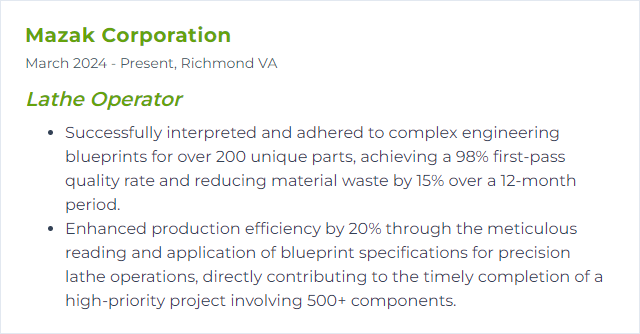
4. Tool Setup
Tool setup covers selecting, mounting, touching off, and aligning tools so they cut correctly. Center height, stickout, nose radius, insert grade, coolant direction—the small things that make or break the cut.
Why It's Important
Solid setups deliver stable cuts, better finish, longer tool life, and safer operation. Sloppy setups burn time and parts.
How to Improve Tool Setup Skills
Get the basics perfect: On-center height for turning tools, minimal stickout, clean toolholders, proper torque.
Check runout: Indicate chucks, collets, and boring bars. Correct issues before they become scrap.
Use quick-change systems: Standard holders, preset offsets, and labeled stations to shrink setup time.
Match tool to material: Insert geometry, grade, and chipbreakers that suit the alloy and cut type.
Dial in coolant: Aim flow at the cut zone; adjust pressure and concentration to help chip control and finish.
Record everything: Keep setup sheets with tool numbers, offsets, nose radii, and proven parameters.
How to Display Tool Setup Skills on Your Resume
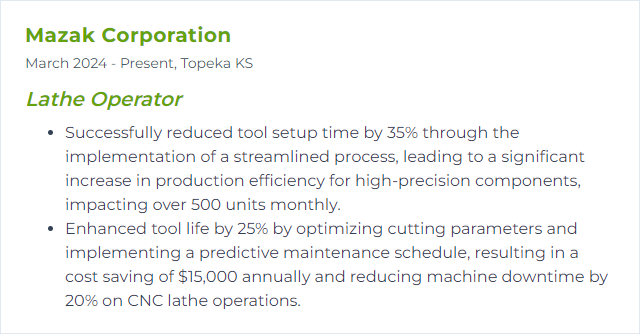
5. G-Code Mastery
G-Code mastery is knowing the control language so well you can read a program like a map and edit it without breaking stride. Modal states, tool comp, canned cycles, macros—under control.
Why It's Important
It lets you correct on the fly, create efficient routines, and avoid risky surprises. Precision with fewer keystrokes.
How to Improve G-Code Mastery Skills
Know the dialect: Your control’s specific G/M codes, quirks, and modal behaviors.
Practice edits: Tighten rapids, clean up arcs, add safe retracts, and swap sequences to shave time.
Use subprograms and macros: Repeat features cleanly, control families of parts with parameters.
Simulate first: Catch gouges, missed clearances, and axis limits before the machine does.
Comment well: Clear labels for tools, ops, and critical dimensions. Your future self will thank you.
How to Display G-Code Mastery Skills on Your Resume
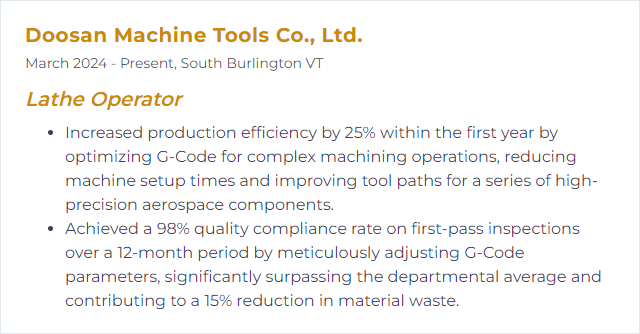
6. CAM Software
CAM software turns models and drawings into toolpaths and code for your lathe. It’s where strategies, feeds, and geometry meet reality.
Why It's Important
Done right, CAM removes manual programming errors, speeds up iteration, and standardizes how parts are made. Faster quoting to chip time, fewer surprises.
How to Improve CAM Software Skills
Master verification: Stock models, machine simulation, collision checks, and gouge detection before posting.
Build libraries: Tooling, holders, materials, and proven feeds/speeds saved as templates.
Tune posts: Match posted code to your control’s needs—safe starts, tool change blocks, and coolant commands.
Use smart strategies: Constant surface speed, rest machining, balanced rough/finish passes, and sensible lead-in/out moves.
Standardize ops: Reusable process templates for common features—facing, OD/ID roughing, threading, parting.
How to Display CAM Software Skills on Your Resume

7. Manual Machining
Manual machining on a lathe is you and the machine—handwheels, dials, feel. Cutting threads, turning tapers, sneaking up on size without code between you and the cut.
Why It's Important
It sharpens instincts. You learn chip color, tool chatter, material behavior, and what a good cut sounds like. Those instincts pay off even on CNC.
How to Improve Manual Machining Skills
Practice fundamentals: Facing square, turning to size, clean chamfers, accurate shoulders, consistent threads.
Chase finish: Experiment with tool geometry, nose radius, and feed/speed to hit surface callouts.
Use proper measuring workflow: Measure at temp, deburr edges, repeat measurements to confirm.
Maintain tools: Sharp inserts, correct rake, and rigid setups minimize chatter and taper.
Document setups: Note compound angles, tool stickout, and tricks that made the job sing.
How to Display Manual Machining Skills on Your Resume
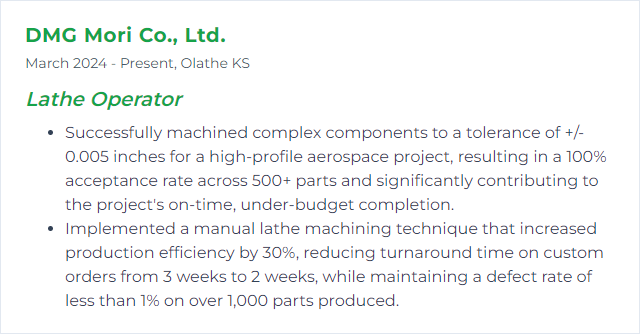
8. Quality Control
Quality control is the routine of planning, checking, and documenting that parts meet print across the run. First article, in-process checks, final inspection—tight and traceable.
Why It's Important
It protects customers and your schedule. Early detection stops scrap from multiplying, and data keeps processes stable.
How to Improve Quality Control Skills
Create control plans: Define critical dimensions, sampling frequency, and gauges ahead of time.
Use SPC: Track key features with control charts; react to trends before limits are busted.
Do true first-article inspections: Prove process capability before unleashing full production.
Maintain gauges: Calibrate, label due dates, and store properly to protect accuracy.
Close the loop: Feed inspection data back to programming and setup to lock in improvements.
How to Display Quality Control Skills on Your Resume

9. Safety Protocols
Safety on a lathe means protective eyewear, secured clothing, tied-back hair, no jewelry, and never gloves near rotating work. Guards in place, chips managed, and respect for moving metal.
Why It's Important
Lathes don’t forgive. Proper protocols prevent entanglement, impact, and flying chip injuries, keeping everyone around the machine intact.
How to Improve Safety Protocols Skills
Train and refresh: Machine hazards, emergency stops, safe threading/parting practices, and chip control—review them regularly.
Lockout/tagout: Service and maintenance only with energy isolated and verified.
Use the right PPE: Safety glasses with side shields, face shield for stringy chips, hearing protection as needed. No gloves at the spindle.
Keep order: Clean floor, no oil slicks, chip bins managed, tools stored. Chaos invites accidents.
Check the machine: Functioning interlocks, guards, and chuck keys removed before start. Verify jaws and bars are secure.
How to Display Safety Protocols Skills on Your Resume
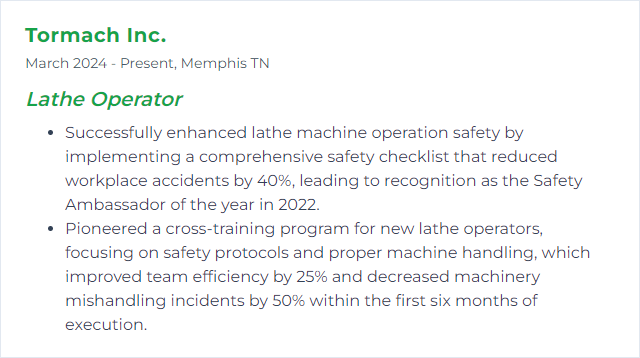
10. Fixture Design
Fixture design is creating workholding that positions and secures parts for consistent machining. On a lathe, that could be soft jaws, pie jaws, collets, mandrels, or custom arbors that make repeatability boringly reliable.
Why It's Important
Rigid workholding improves accuracy, reduces cycle time, and speeds changeovers. The right fixture can turn a tricky job into routine production.
How to Improve Fixture Design Skills
Start from the print: Let datums and tolerances dictate where and how you locate and clamp.
Prioritize rigidity: Maximize contact area, minimize overhang, and support thin walls to prevent distortion.
Design for speed: Quick clamps, clear chip paths, and easy loading orientations save minutes every cycle.
Go modular: Reusable bases and standardized features cut future setup time.
Prove and iterate: Test with a few parts, then tweak jaw geometry, stop locations, and clamping pressure.
How to Display Fixture Design Skills on Your Resume
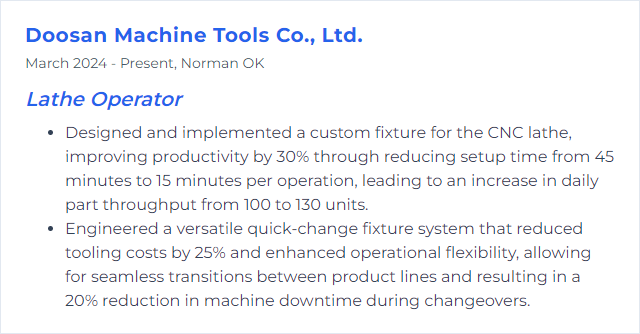
11. Tolerance Analysis
Tolerance analysis evaluates how part variations stack up so assemblies still fit and function. For turning, that means knowing what each operation can hold and how process drift affects the final geometry.
Why It's Important
It prevents nasty surprises at assembly and helps set realistic, capable tolerances upstream. Less scrap, fewer concessions.
How to Improve Tolerance Analysis Skills
Map critical features: Identify datums and key-to-function dimensions. Tie checks to those.
Quantify capability: Measure process variation and calculate Cp/Cpk for tight features.
Control contributors: Reduce tool wear variation, thermal growth, and workholding error with specific countermeasures.
Use GD&T well: Apply position, runout, and profile controls to match real function, not wishful thinking.
Close the loop: Adjust stock allowances, sequences, and finish passes based on actual data.
How to Display Tolerance Analysis Skills on Your Resume
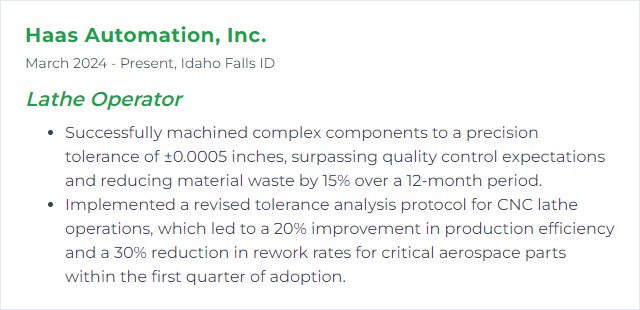
12. Machine Maintenance
Machine maintenance is the rhythm of cleaning, lubricating, inspecting, and adjusting so the lathe stays accurate and reliable. Smooth slides, true spindles, responsive controls.
Why It's Important
Healthy machines make good parts. It reduces downtime, extends service life, and protects operators from malfunction risks.
How to Improve Machine Maintenance Skills
Daily checks: Wipe ways, check oil and coolant levels, look for leaks, listen for odd noise, warm up the spindle.
Schedule PM: Alignments, backlash checks, filter changes, and lubrication system verification on a set cadence.
Keep it clean: Chips out of slides and guards, coolant sumps skimmed, electrical cabinets dust-free.
Lockout/tagout: Service safely. Verify zero energy before you wrench.
Record everything: Maintenance logs, fault codes, and corrective actions—use them to predict and prevent failures.
How to Display Machine Maintenance Skills on Your Resume
